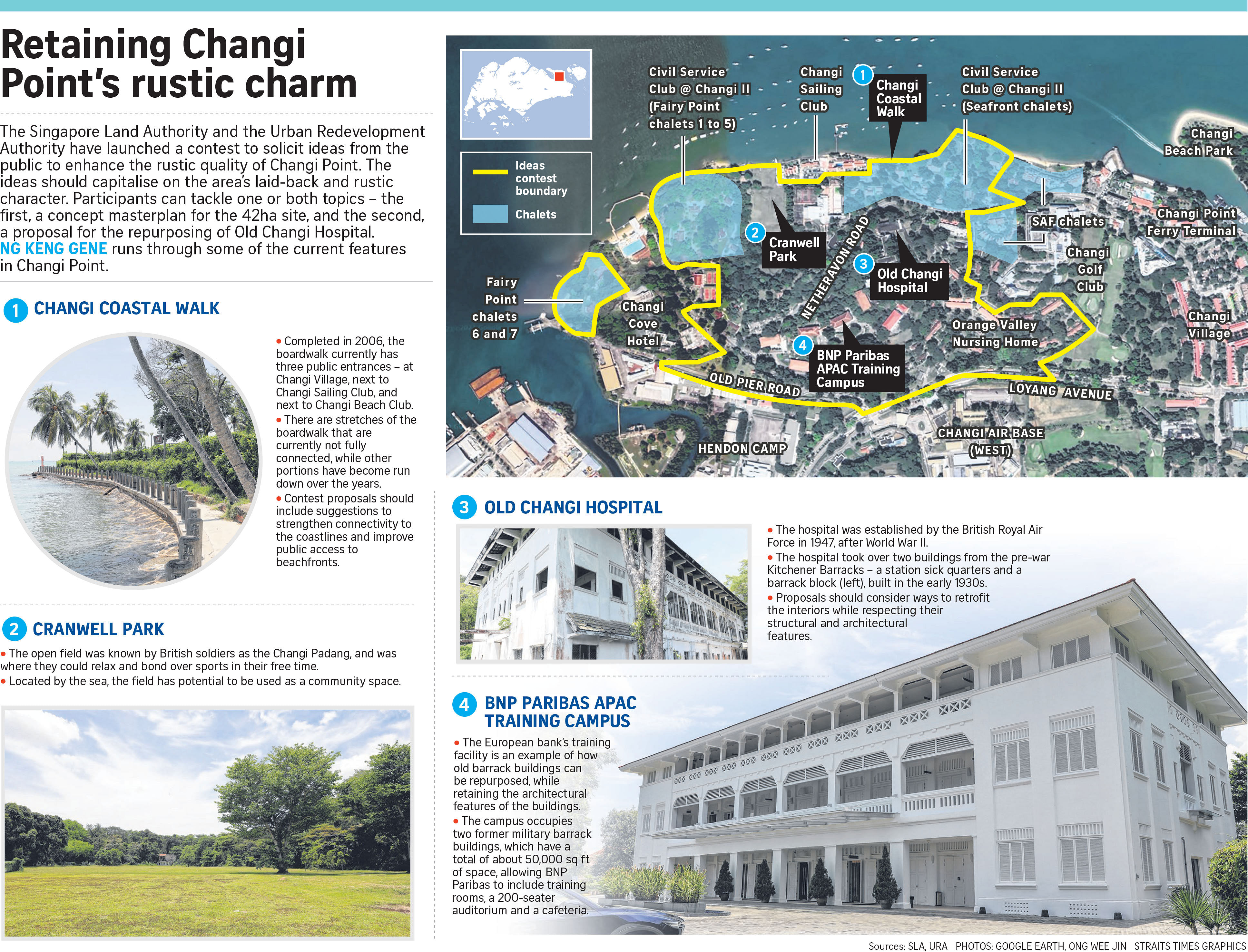Can the derelict Old Changi Hospital, a site for many a ghost-hunting expedition, find new life?
The authorities hope so, and want ideas on how to repurpose it, as well as the history-rich Changi Point, while retaining its charm.
Bearing in mind the area's current zoning for sports and recreation, the Singapore Land Authority (SLA) and the Urban Redevelopment Authority (URA) have launched a contest seeking ideas to enhance the area, while retaining its abundant built and natural heritage.
The contest began yesterday and will run till June 9 this year when submissions are closed.
Entries can be submitted in two categories - for students in design-related disciplines in tertiary institutions, and an open category for all from other backgrounds.
Participants can tackle one or both challenges. The first challenge requires devising a concept masterplan that guides enhancement of a 42ha area within Changi Point. The area is bounded by Loyang Avenue and Changi Air Base (West) to the south and Changi Golf Club to the east. The second sees participants suggesting ideas to repurpose Old Changi Hospital.
For the concept masterplan, participants are to balance retaining the quiet, rustic character of the area while suggesting enhancements that might attract more visitors to Changi Point.
To achieve this, participants are advised to suggest ways of repurposing existing infrastructure in the area, instead of proposing intensive development works.
The contest also prompts participants to include community spaces within the site, and improve accessibility, especially to the coastline that borders the area's north.
As for Old Changi Hospital, participants are invited to submit ideas that give it a new lease of life while retaining its buildings' architectural features.
Heritage author Jerome Lim, who researched the hospital's history, said records show that the site was used as a fully functioning hospital only after World War II from 1947, when the British Royal Air Force took over the buildings at Changi Point.
Asked about rumours of paranormal sightings at the old hospital, he said these were likely unfounded, and probably became popular only after the hospital ceased operations in 1997.
"While the eventual hospital building did serve as a prisoner-of-war (POW) camp, it was only for a short period between February 1942 and May 1943.
-
Contest requirements
-
TOPIC 1: CONCEPT MASTERPLAN FOR CHANGI POINT
The masterplan should provide a clear and coherent structure for the enhancement of Changi Point, and include:
• A strategy for positioning Changi Point
The proposal should differentiate Changi Point from other recreational or lifestyle nodes in Singapore, and capitalise on the rustic qualities as well as the built and natural heritage of the area.
• Uses and concepts for buildings
While minor sensitive extensions to the buildings can be considered, major revamps should be avoided. The introduction of uses involving higher activity levels or visitor footfall should be confined only to localised areas, such as within the Old Changi Hospital site.
• Community spaces
Such spaces are to be identified, with programmes that could involve various communities and stakeholders.
• Sensitive development works
Any proposed infill developments should be in line with the overall intent to retain the rustic charm, and preserve the existing biodiversity and environment.
• Connectivity to public transport nodes and enhanced public accessibility
Proposals can consider dedicated pedestrian footpaths and cycling paths to connect the buildings, green spaces and the waterfront area.
TOPIC 2: REPURPOSING OF OLD CHANGI HOSPITAL
The proposal should give it a new lease of life while retaining its architectural features, and include:
• A strategy that considers the hospital's multifaceted identity
• Uses that relate to the history, terrain and context of the wider Changi Point area
• Ways to retrofit the buildings' interiors while respecting their structural and architectural features
• Supporting infrastructure such as ramps, parking lots and footpaths.
"According to accounts, life was relatively more pleasant here for prisoners of war than it was elsewhere, and there were no records or accounts of hospital tortures, meaning the rumours are likely untrue," said Mr Lim.
In fact, during the days of the camp, the POW hospital was at Roberts Barracks, a site which is within the current Changi Air Base (West), said Mr Lim.
In a statement yesterday, URA and SLA said suitable ideas and concepts from the contest will be "distilled into the design principles and planning parameters for the site".
Ms Yap Eai-Sy, SLA's director of business planning and development as well as leasing, added that the ideas canvassed will help build on the area's unique identity and military heritage, with its location along the 50km-long Greater Rustic Coast that spans Lim Chu Kang to Changi.
Within the contest boundary are 10 commercial blocks, 23 residential blocks with a total of 71 units, and 24 chalet blocks.
Among them are two old barrack buildings - 34 and 35 Hendon Road - which now house European bank BNP Paribas' Asia-Pacific training campus.
The bank's head of human resources for South-east Asia, Ms Theresa Ho, said it chose to sink its roots in the historic buildings to mimic the theme of its Paris campus, situated in a 23ha estate that dates back to the 18th century.
"Changi Point is a very beautiful place. It's away from the hustle and bustle of the city, and our staff can focus on learning, and enjoy the blue skies, greenery and sea view," she said.
"And I think what would be disappointing is if the Government were to destroy all these buildings, and then construct another (modern) building. Where is the charm? Where is the character? Where is the history? These things will be gone," said Ms Ho. She hopes more firms would see value in repurposing old buildings in the area.
The contest's jury will comprise representatives from the public and private sectors of various related disciplines, said SLA and URA.
Prizes will be awarded for the top three proposals in each of the two categories - open and tertiary - with prize money ranging from $2,000 to $6,000 for the open category, and $1,000 to $3,000 for tertiary students.
Those interested in the contest can find out more about it and register at www.ideas.gov.sg/public/Charmingly_Changi


